The state of Mississippi is located in the southeastern part of the country, neighboring Alabama, Tennessee, Arkansas, Louisiana, and the Gulf of Mexico. The Magnolia State is home to some of the country’s major rivers and features lowlands and large bays. In this article, we discuss some amazing, endangered animals in Mississippi!
The state has a humid subtropical climate, with short, mild winters and hot summers. This makes a great habitat for both flora and fauna, as they don’t have to adapt to harsh winter weather. However, habitat destruction, pollution, and collection for the pet trade threaten several species.
If you’re planning a visit to the Hospitality State and want to learn about some of the rarest animal species living there, keep reading!
1. Scalloped Hammerhead

The scalloped hammerhead is a hammerhead shark species currently listed as Critically Endangered.
©Ian Scott/Shutterstock.com
The scalloped hammerhead is a hammerhead shark species currently listed as Critically Endangered. Although they widely inhabit coastal warm-temperate and tropical seas, their population is steadily declining.
The population numbers vary based on the sex of the animal, since females move only regionally while males move across ocean basins. Scientists estimate a population reduction of 76.9 – 97.3% due to sharks caught as targets and bycatch.
Conservationists applied measures in all their habitats. However, only the Northwest Atlantic and Gulf of Mexico populations responded well and showed signs of stabilization.
The scalloped hammerhead is pretty large, measuring around 4.9 – 5.9 feet and weighing roughly 64 pounds. Females are often larger than males, reaching 8.2 feet long and 80 pounds. These sharks have large and complex brains and are capable of social intelligence, complex habitat relationships, and sensorimotor functions.
2. Alabama Red-Bellied Cooter

The Alabama red-bellied cooter is a turtle in the Emydidae family.
©Alabama_red-bellied_turtle_US_FWS.jpg: Josh Roswell/U.S. Fish and Wildlife Service / public domain – License
The Alabama red-bellied cooter is a turtle in the Emydidae family. Its scientific name is Pseudemys alabamensis. These turtles aren’t very large, with females measuring around 12 inches while males can reach 14 inches.
While this turtle is Alabama’s official state reptile, it now inhabits Mississippi and Florida, too. In Mississippi, it lives in the southeastern part, precisely in Harrison and Jackson counties.
The species was listed as Endangered in 1996. However, researchers know little about the Alabama red-bellied cooter population, which is why conservationists haven’t updated their status for almost three decades.
3. Pearl River Map Turtle
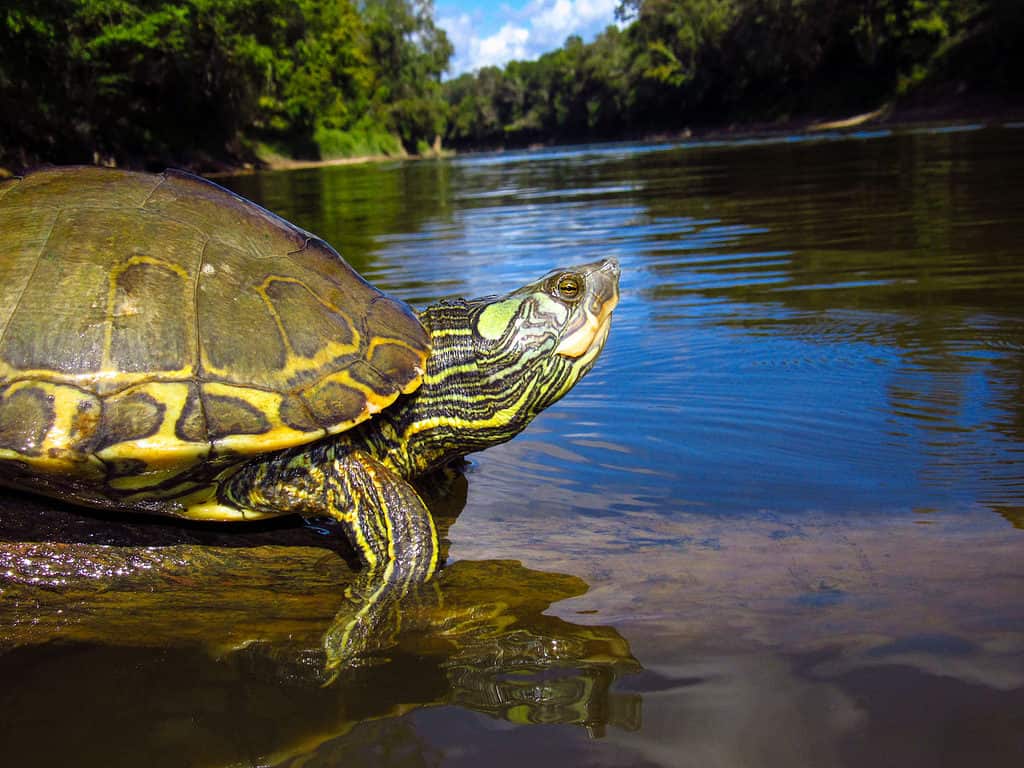
Pearl River map turtles inhabit the major tributaries of the Bogue Chitto and Pearl rivers.
©Gabbie Berry/Shutterstock.com
Native to the southern United States, Graptemys pearlensis is an emydid turtle living only in Mississippi and Louisiana. These turtles inhabit the major tributaries of the Bogue Chitto and Pearl rivers, occupying 584 miles of river length.
Female Pearl River map turtles have a carapace length of up to 11.6 inches, while males are much smaller, reaching only 4.7 inches.
These turtles were listed as Endangered in 2010 because available information suggested that their population had decreased by 80 – 98% since 1950. The primary reasons for such a drastic drop are pollution and habitat destruction. The Pearl River system, for example, was subject to pollution from riverside paper industries and riverine gravel mining. While the habitat situation has improved slightly, the population did not appear to recover.
4. Pallid Sturgeon
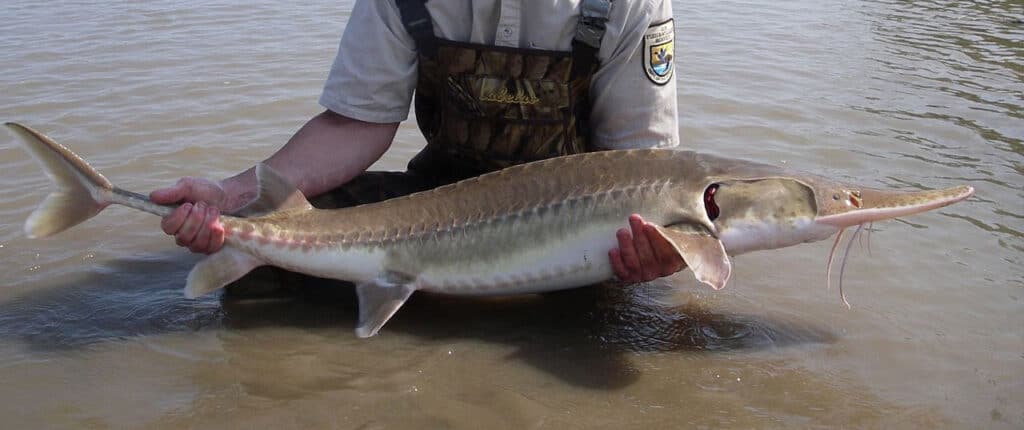
The primary threats to the pallid sturgeon population in the lower Missouri River are anthropogenic modifications.
©U.S. Fish and Wildlife Service / public domain – License
The pallid sturgeon is a ray-finned fish endemic to the Missouri and Mississippi river basins. These fish are close relatives of shovelnose sturgeons, except that they’re much larger, reaching 60 inches in length and 85 pounds in weight.
This species is thought to have inhabited our planet for 70 million years! Their current endangerment is deeply concerning, as it indicates how much urbanization and human actions have negatively impacted aquatic ecosystems. The last assessment showed that only 11,700 mature individuals remain, and the numbers are steadily decreasing.
The primary threats to the pallid sturgeon population in the lower Missouri River are anthropogenic modifications. The water surface reduced by half, the current velocity doubled, and sediment transport and habitat diversity decreased. In the Upper Missouri River, the dams threaten populations. At the same time, pallid sturgeons suffer from channelization, snag removal, floodways and spillways, and bank stabilization in the Mississippi River.
5. Variable Cuckoo Bumblebee
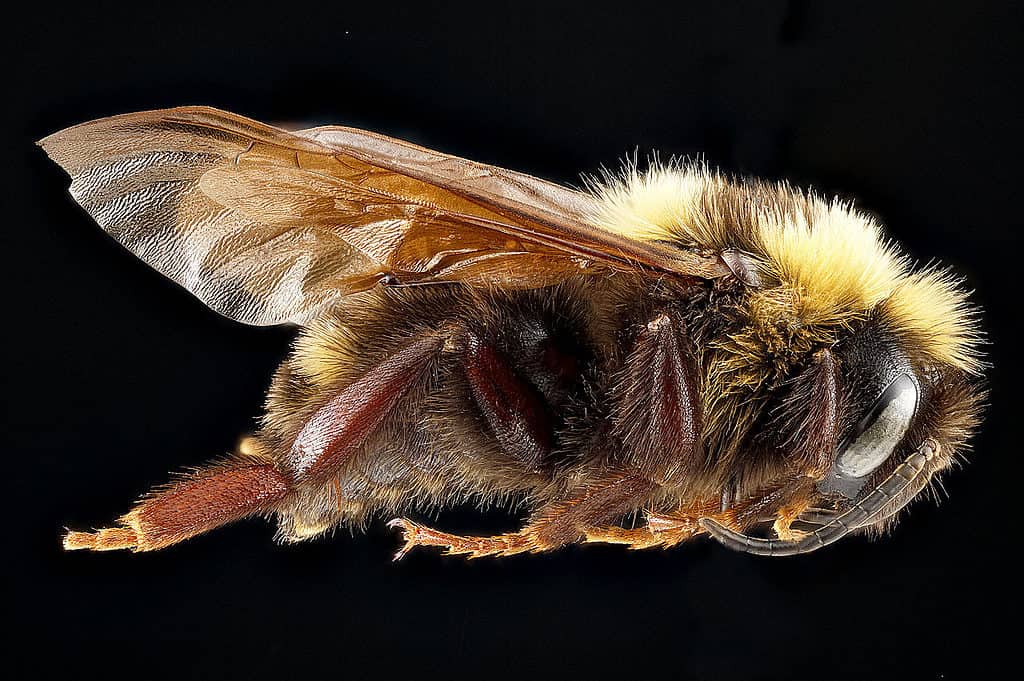
The variable cuckoo bumblebee is a critically endangered cuckoo bumblebee species.
©USGS Native Bee Inventory and Monitoring Laboratory / CC BY 2.0 – License
The variable cuckoo bumblebee is a critically endangered species. Conservationists know little about this species’ population. Researchers think they inhabit Guatemala and Mexico, while they’ve gone extinct in Canada and the United States, Mississippi included. However, until further confirmation, we can certainly hope they’re still flying through at least some U.S. states!
The population dropped in the 1920s, eventually leading the variable cuckoo bumblebee to become one of the world’s rarest insects.
Many factors affect these bumblebees. These include pesticide use, habitat loss, competition with non-native bees, climate change, and pathogens from managed pollinators. However, the population of their host species also greatly affects them, since variable cuckoo bumblebees are parasitic. Their only known host species is Bombus pensylvanicus, whose population has also declined.
6. Blacknose Shark

The blacknose shark is a requiem shark that lives in tropical and subtropical waters at depths ranging from 59 to 210 feet.
©iStock.com/ Ryan Cake
The blacknose shark, which belongs to the Carcharhinidae family, is a requiem shark that lives in tropical and subtropical waters at depths ranging from 59 to 210 feet. It measures around 4.3 – 4.6 feet long and weighs around 22 pounds. The largest blacknose shark measured 6.6 feet long and weighed 42 pounds. These sharks have rounded snouts, large eyes, and small dorsal fins.
The species is currently Endangered, and its population is constantly decreasing, primarily because of hunting. Bycatch is another major threat. Over the past 32 years, the blacknose shark population has registered a 50-79% reduction.
The Consolidated Atlantic Highly Migratory Species Federal Management Plant, which aims to protect endangered species, manages the blacknose shark population.
7. Pascagoula Map Turtle
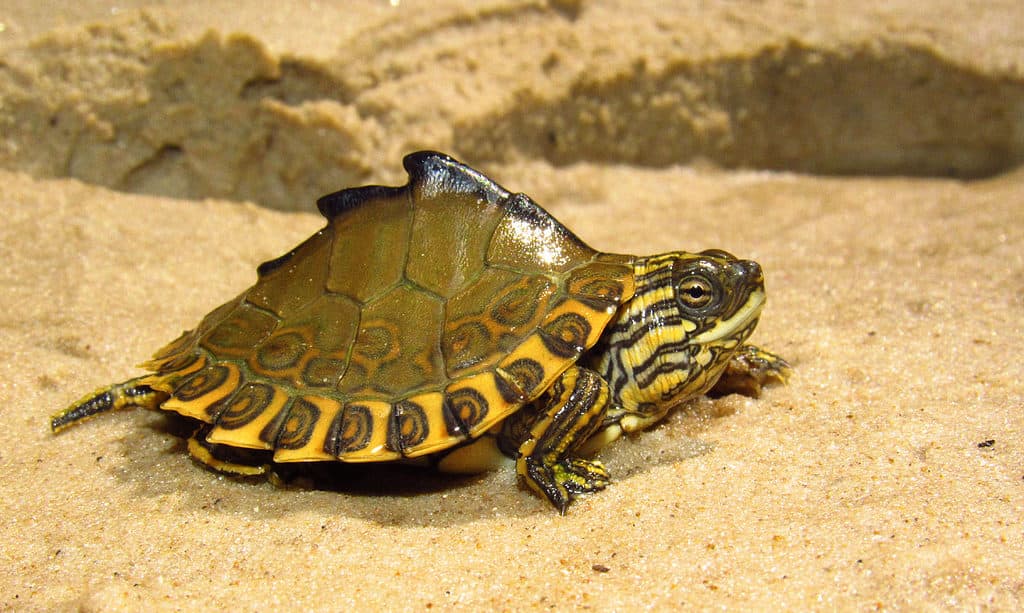
The Pascagoula map turtle is considered the second rarest
Graptemysspecies.
©Gabbie Berry/Shutterstock.com
The Pascagoula map turtle lives only in the Pascagoula River in the United States, which is located in southeastern Mississippi and spans 472 miles. The species is endangered and is the second rarest Graptemys species.
Water pollution affects their main food source, the mollusks, thereby threatening their population. Channelization, snag and log removal, collection for the pet trade, and wanton destruction by fishermen are other major threats. Riverside paper industries and riverine gravel mining has polluted parts of the Pascagoula River systems, which caused a population drop. The authorities are currently trying to protect and improve water quality, discourage channelization, and prohibit commercial collecting.
8. Snuffbox Mussel
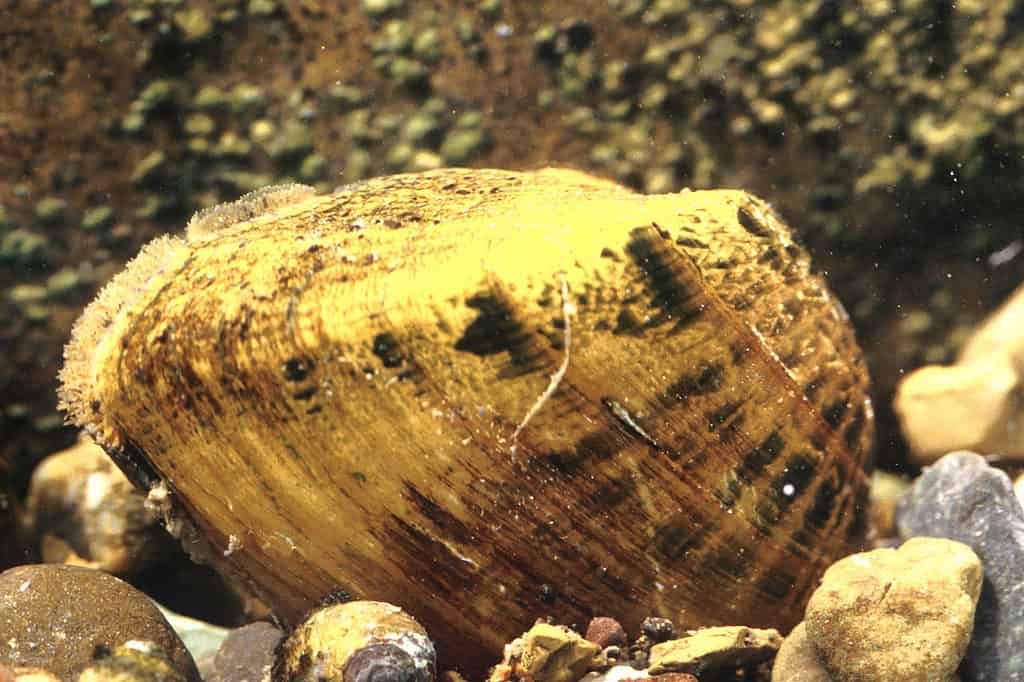
These animals are part of the
Unionidaefamily of freshwater mussels.
©Dick Biggins, U.S. Fish and Wildlife Service, Public domain, via Wikimedia Commons – License
The snuffbox mussels’ scientific name is Epioblasma triquetra. They are part of the Unionidae family of freshwater mussels. These mussels inhabit the Great Lakes system and the Mississippi River system.
This endangered species is possibly extinct in Mississippi, Iowa, Kansas, and New York. However, there’s no confirmation regarding this. It’s possible that habitat destruction and pollution haven’t yet caused the disappearance of another Mississippi animal species.
Research shows that their population registered a 90% reduction, meaning it’s on the brink of extinction. Luckily, the United States and Canada offer legal protection for the snuffbox mussel. Hopefully, this will help stabilize the population in the future. Interestingly, snuffbox mussels are the most abundant species in the Epioblasma genus, as most of their other relatives went extinct.
9. Arogos Skipper

The arogos skipper is also called the beard-grass skipper.
©Charles T. and John R. Bryson, , Bugwood.org / CC BY 3.0 US – License
The arogos skipper, or beard-grass skipper, is a butterfly that is part of the Hesperiidae family. The insect has a wingspan of 1.1 – 1.4 inches and a yellowish-brown body.
This species is a resident of several U.S. states, Mississippi included. However, it has gone extinct in Pennsylvania. Their population is constantly decreasing due to habitat fragmentation and degradation. Arogos skippers live in small, isolated colonies and are thus vulnerable to extinction.
Moreover, these insects depend on remnant native prairie patches, which conversion for grazing, agriculture, and development threaten. This can further affect the arogos skipper population.
10. Southern Plains Bumblebee
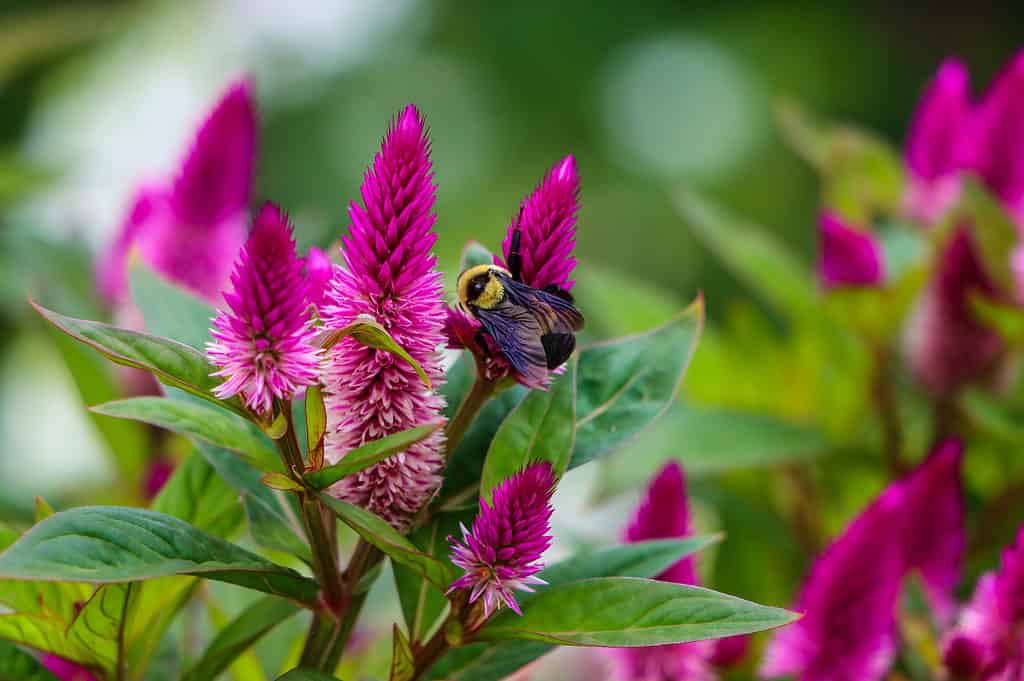
The Southern Plains bumblebee is a bumblebee species living primarily east of the Rocky Mountains.
©Lisa Basile Ellwood/Shutterstock.com
The Southern Plains bumblebee, or the Bombus fraternus, is a bumblebee species living primarily east of the Rocky Mountains. These bumblebees have black bodies covered with yellow bands on the thorax and abdomen. They are pretty large, with queens measuring around 0.97 – 1.07 inches and workers reaching 0.56 – 0.75 inches.
Pesticide use, habitat loss, climate change, and pathogens from managed pollinators all threatened the population to the point of endangerment in 2014.
Up Next:
- Discover The 10 Largest Animals In Mississippi, and Where You’ll Find Them
- Discover 6 Extinct Animals That Lived in Mississippi
- Which First: The Mississippi River or Mississippi the State?
The photo featured at the top of this post is © iStock.com/rmbarricarte
Thank you for reading! Have some feedback for us? Contact the AZ Animals editorial team.







